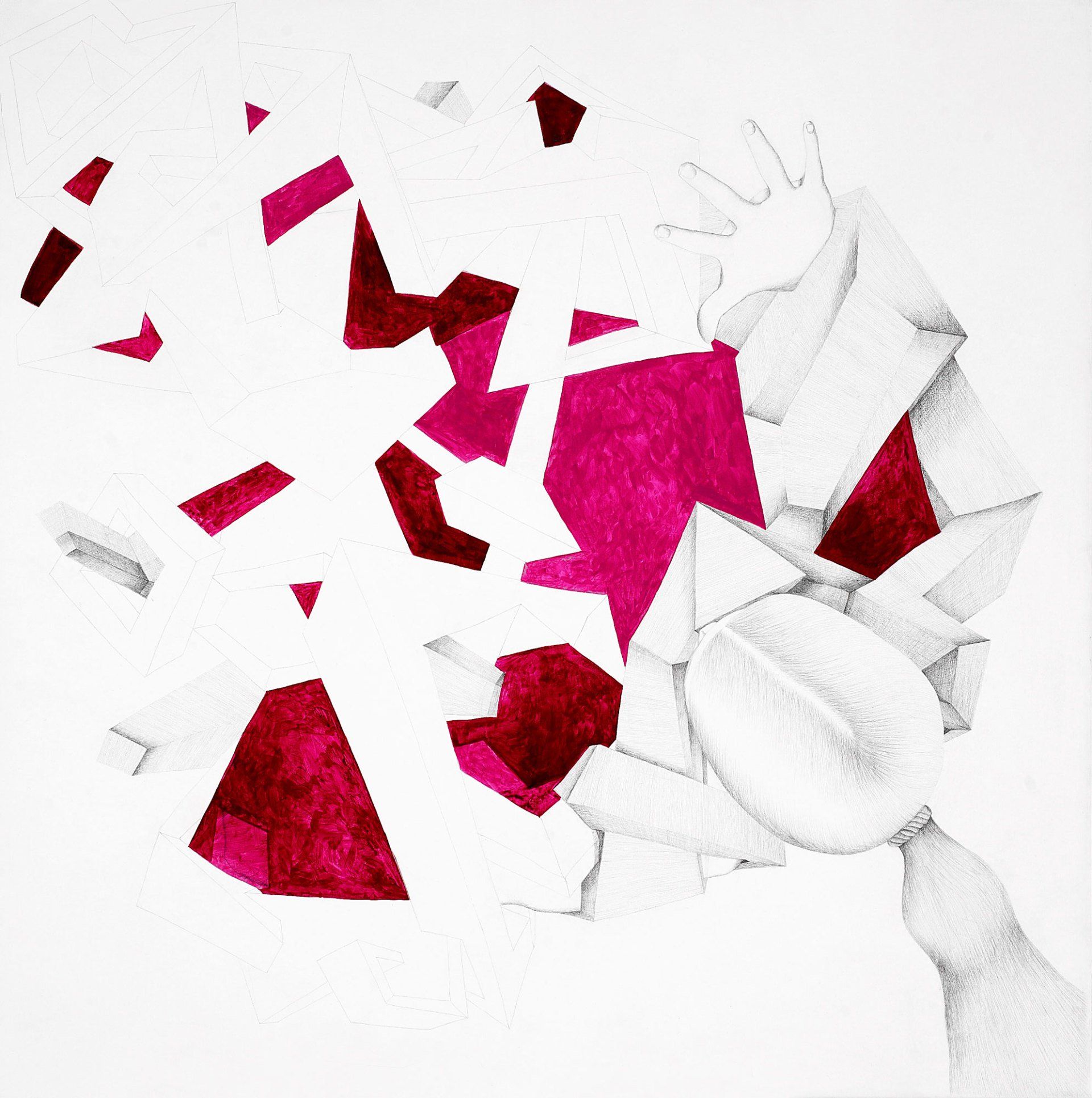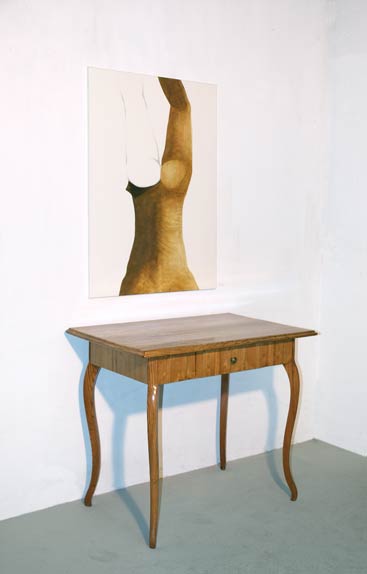
Vis-à-vis. Towards the Space beyond Space
Windows, doors, walls, ceilings, floors, corners–general architectural features of a room–are fragmentarily taken over in drawings. Site-specific commodities of the interior are connected to the pictures as objects in an installation. The pictorial space determined in this way is occupied and used by a stereotypical (female) figure that appears again and again: She hides under presented furniture, sleeps on it, lies on the floor, looks out from under a window sill ...
These drawings leave their fixed role as simple murals and demand their share of space by tearing an opening in the membrane of the real room and thus referring to another, otherwise invisible, level.
They are bi-dimensional pictures that are at the same time conceived as three-dimensional objects: drawings that lie on the floor or stand free in space, like the diptych of a figure walking through the wall: She steps in as a fragment of an upper body on one side of the screen penetrates through a gap to the other side. The diptych can be experienced through its positioning in the room as an object that has detached itself from the wall and now stands independently in the room. Breaking through the surface of the wall–to the space beyond the space–is the instruction for the life-size protagonist, who appears in different situations and roles in all drawings. In her movement from one side of the room to the other, she is always shown in a transitional position, the direction of which is ambivalent: Is she entering the canvas or tearing herself out of the picture space in order to enter the real space? She is never recognizable as a whole figure, only individual parts of her body become visible, while the rest is wrapped and hidden in decorative fabrics that are reminiscent of constricting safety nets, which are at the same time protect the figure.
This protagonist always remains anonymous, eludes identification by the viewer in that she is almost exclusively turned away or shown from behind. Formally, her stiff positions make her appear rather inanimate, like a humanoid from science fiction films frozen in a symbolic gesture. Her gender can be guessed by the long hair, breasts and clothing, that suggest the representation of a female figure. At the same time, the athletic body contradicts this assumption. It is an androgynous figure who defies clear identification and refers as an archetype to every human being.
The pictorial space is also a psychological space in which this depersonalized protagonist struggles for a place, for an identity. Through its life-size representation, it becomes a virtual counterpart for the viewer, coming face-to-face, populating its pictorial space like real visitors in the exhibition space.
The theme of overcoming dichotomy continues through the topic of real space versus pictorial space, stereotype versus individual, animate versus inanimate, threat versus protection, and reappears in the technical approach to the drawing. Here, too, the connection between two opposing poles determines the picture: drawing and painting. The contrast between drawn and painted zones dissolves through the gradual perception of the pictures in the room: If you look from a greater distance, the colored areas are initially perceptible, if you approach the pictures, the delicately drawn zones–mostly the figure–gradually become recognizable. In this way the movement of the viewer becomes an immanent element of the drawings, which can only be fully experienced through this movement.
The pictures are created using a mixed technique of pencil and acrylic paint based on precise preliminary sketches. Canvas serves as a wall-like surface and is elaborately pretreated, primed and sanded several times so that its structure corresponds to a rough paper surface. The priming enables the pencil drawing to be applied and creates the background, the actual picture space. The formats vary from large formats to small formats. Only the life-size representation of the figure is common to all works, even if the small formats are only fragments such as fingers, forehead or hair.
The decision to apply the drawing on canvas and not directly on the wall reinforces both the image and the object character of the drawings. The picture dissolves through the white canvas surface with the surrounding area. At the same time, the frame makes it stand out from the wall, giving it its own plasticity. The fact that the drawing is on canvas, thus having its own space, also allows it to be transferred to another room. In this way, images that were initially created as site-specific works for a specific space, occupy new spaces and develop a different effect by changing their original meaning and that of their new surroundings. This transfer also takes place in the context of this catalog: from the real space back into the two-dimensional space of the page: to the space beyond space.
Anemona Crisan












